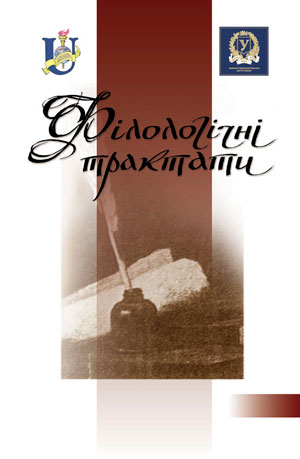THE METAPHORICAL REPRESENTATION OF THE CONCEPT OF «LABYRINTH» IN B. ANTONENKO-DAVYDOVYCH’S CREATION
Keywords:
concept, labyrinth, life-labyrinth, path entanglement, depression, crisis, «borderline» situationAbstract
The article is devoted to the research of the peculiarities of the artistic content of the concept of «labyrinth» in B. Antonenko-Davydovych’s creative heritage. The structure of the labyrinth is defined not only by its direct meaning as a building from which it is difficult or impossible to find a way out, but also by the entanglement of relationships, situations, thoughts, actions etc. B. Antonenko-Davydovych’s works do not have the word «labyrinth» in their titles, but the life collisions of the characters in these works appeal to this very concept, which is a symbol of being, the idea of eternal return, the circle of life, relentless search, constant choice etc. The writer represents the existence of the characters as a labyrinth with a large number of decisions and a choice of actions, both true and false, in order to achieve spiritual balance. His characters often find themselves in a kind of labyrinth of events, feelings, emotions and, most importantly, their own interpretations of these events. The artist appeals to the metaphorical representation of the concept of «labyrinth» in order to focus attention on the complexity and entanglement of life in the chaos of the era. In the author’s works, the concept of «labyrinth» embodies the idea of searches, random movement, deviation from a rational path. In B. Antonenko-Davydovych’s creation the functioning of the concept of «labyrinth» as wanderings caused by the revolution and as the entanglement of life’s path and fate is highlighted in the novel «Za shyrmoiu» («Behind the curtain»), the stories «Smert» («Death»), «Tuk-tuk», «Zavyshcheni otsinky», «Shchastia». The peculiarity of the labyrinth is that its construction involves finding an exit or is marked by the impasse. One of the consequences of getting out of the life labyrinth can be death – one’s own («Tuk-tuk»), a loved one’s («Za shyrmoiu» («Behind the curtain»)), someone else’s («Smert» («Death»)). In the story «Shchastia» the exit from the labyrinth is marked as the understanding of the life, the acceptance of the past, that is a kind of rebirth. The story «Zavyshcheni otsinky» contains an indication of the impasse of the main character from the labyrinth.References
Антоненко-Давидович Б. Д. Смерть. Сибірські новели. Завищені оцінки: Повісті, новели, оповідання / упоряд. Б. О. Тимошенко; передм. Л. С. Бойка. Київ: Рад. письменник, 1989. 559 с.
Антоненко-Давидович Б. Д. Твори в 2 т. Київ: Наук. думка, 1999. Т.1: Повісті та романи / вступ. ст., упорядкув. та прим. Л. С. Бойка. 744 с.
Антоненко-Давидович, 1999b – Антоненко-Давидович Б. Д. Твори: в 2 т. Київ: Наук. думка, 1999. Т.2: Сибірські новели. Оповідання. Публіцистика. Спогади. Листування / упорядкув. та прим. Л. С. Бойка. 656 с.
Білобровська К. О. Картина як антиципація подій у романі Б. Антоненка-Давидовича «За ширмою». International scientific conference «Current trends and fields of philological studies in the challenging reality»: conference proceedings (July 29–30, 2022. Riga, the Republic of Latvia). Riga, Latvia: «Baltija Publishing», 2022. P. 63–68.
Білобровська К. О. Концепт «сонце» vs архетип Тінь у повісті Б. Антоненка-Давидовича «Смерть». Філологія початку ХХІ сторіччя: традиції та новаторство: матеріали Міжнар. наук.-практ. конф., 30 вересня–1 жовтня 2022 р., м. Київ. Львів-Торунь: Liha-Pres, 2022. С. 7–12.
Бондарь Н. Ю. Путь-лабиринт как разновидность архетипа дороги в английской литературе. Наукові записки ХНПУ імені Г. С. Сковороди. 2017. Вип. 1 (85). С. 16–25.
Дмитренко В. І. Б. Д. Антоненко-Давидович у літературному процесі 20-30 х років: автореф. дис. … канд. філол. наук: 10.01.01. Київ, 1997. 24 с.
Дмитренко В. І. Оніричний простір повісті «Смерть» Б. Антоненка-Давидовича. Науковий вісник Миколаївського державного університету імені В. О. Сухомлинського. Сер.: Філологічні науки. 2014. Вип. 4.13. С. 76–82.
Керлот, 1994 – Керлот Х. Э. Словарь символов. Москва: «REFL-book», 1994, 608 с.
Локатир Н. М. Громадсько-політична та наукова діяльність Миколи Шлемкевича (1894-1966 рр.): дис. … канд. іст. наук: 07.00.01. Івано-Франківськ, 2018. 249 с.
Махній М. М. Поняття людської долі в контексті життєвого світу особистості. Вісник Чернігівського національного педагогічного університету. Сер.: Психологічні науки. 2013. Вип. 114. С. 134–139.
Набитович І. Й. Концепт лабіринту як сакрального локусу (на прикладі новелістики Х. Л. Борхеса, романів У. Еко «Ім’я рози» та К. Мосс «Лабіринт»). Маґістеріум. Літературознавчі студії. 2010. Вип. 38. С. 45–51.
Нестелєєв М. А. Автодеструктивне пограниччя у творах Бориса Антоненка-Давидовича. Вісник Львівського університету. Серія філологічна. 2014. Вип. 60 (2). С. 262–266.
Панок В. Г., Рудь Г. В. Психологія життєвого шляху особистості. Київ: Ніка-Центр, 2006. 280 с.
Протопопова К. О. Домінантний концепт повісті Б. Антоненка-Давидовича «Смерть». Літератури світу: поетика, ментальність і духовність. 2021. Вип. 15. С. 55–75.
Протопопова К. О. Концепт «щастя» у художньому вимірі Б. Антоненка-Давидовича. Вісник Житомирського державного університету імені Івана Франка. Філологічні науки. 2021. Вип. 1 (94). С. 36–48.
Савчук Р. І. Лабіринт як знаковий фіксатор наративної стратегії «експресія» у французькому художньому текстотворенні XX ст. (на матеріалі роману А. Роб-Грійє «Dans le Labyrinthe»). Вісник Київського національного лінгвістичного університету. Серія: Філологія. 2018. Т. 21, № 1. С. 81–89.
Хамедова О. А. Feci, quod potui... Доля і творчість Бориса Антоненка-Давидовича: монографія. Донецьк: Норд-Прес, 2009. 164 с.
Хмель, 2006 – Хмель О. С. Екзистенціалістські мотиви в «Сибірських новелах» Б. Антоненка-Давидовича: автореф. дис. … канд. філол. наук: 10.01.01. Харків, 2006. 21 с.
Шлемкевич М. Загублена українська людина. Життя і мислі. Нью-Йорк. 1954. 158 с.













